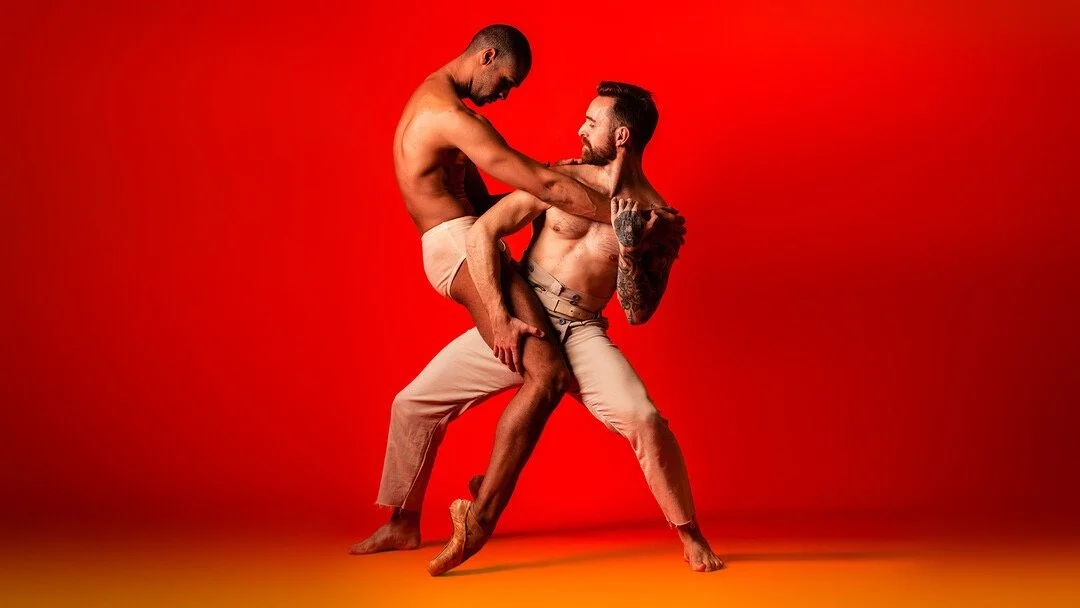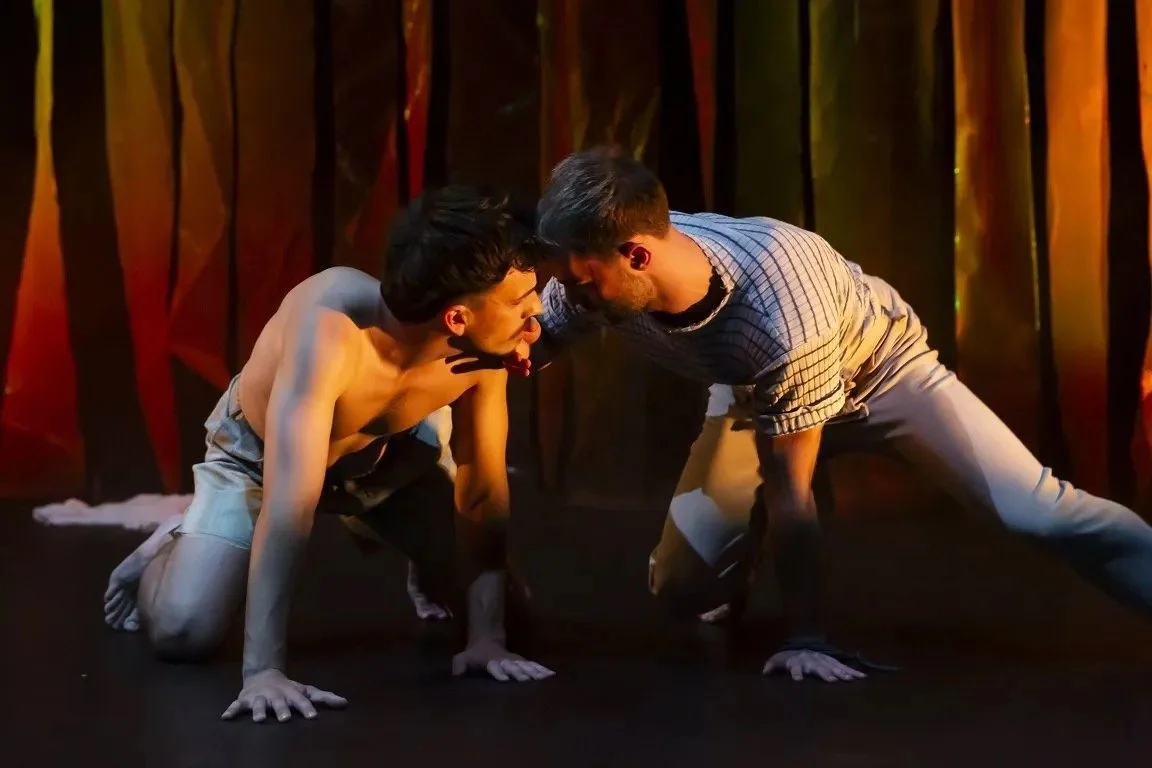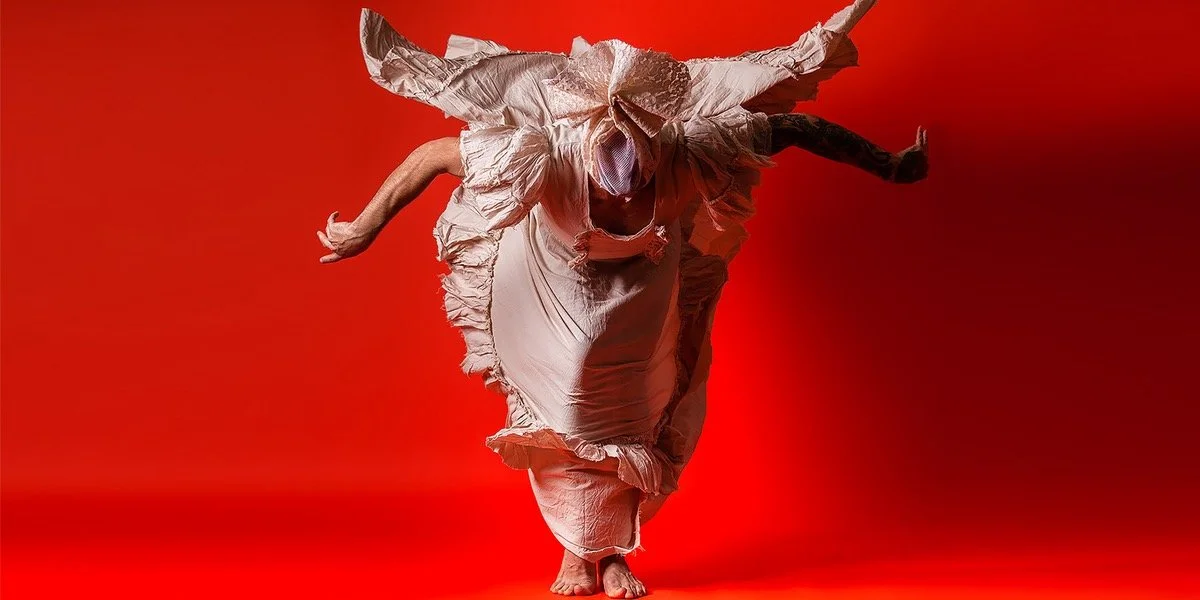Carlos Pons Guerra
an interview with
choreographer Carlos Pons Guerra
Carlos Pons Guerra, a choreographer from Gran Canaria, Spain, has been creating dance since 2012, when he founded DeNada Dance Theatre, an independent LGBTQ+ dance company dedicated to amplifying underrepresented voices. Drawing from Hispanic and Latinx heritage, the company blends theatrical extravagance with compelling narratives to champion diversity and inclusion.
In this interview, we discuss Mariposa, Carlos’s queer reimagining of Madame Butterfly, presented at The Place in London on 25 and 26 February. Set in post-revolution Cuba under the neon glow of a Caribbean port, Mariposa follows a rent boy and a foreign sailor as they navigate desire, sacrifice, and fate. This operatic dance drama reclaims Puccini’s Orientalist libretto and opens up a conversation about queerness and the hostility it faces in today’s political climate. Through a world of faded showgirls, hopeful lovers, and Santería spirits, Mariposa is a powerful meditation on love, survival, and belonging.
Giuliano: Tell us a little bit about your show, Mariposa. How did it come to life?
Carlos: Mariposa is a camp spectacular: a big, emotional, queer drama. It is very theatrical, features an excellent cast of dancers, and tells a story that is both heart-wrenching and hopeful. It actually grew out of my own background. When I was a child, my grandmother used to take me to the opera. One of my earliest memories is seeing Madama Butterfly, which, as I realize now, shaped a lot of my adult life. I have been obsessed with the story ever since, whether it is the original Puccini opera, Miss Saigon, or various ballet adaptations. Around 2016, I saw a ballet version of Madama Butterfly and felt compelled to make my own interpretation. I wanted to address what I felt were oversimplifications and harmful stereotypes in the original, particularly regarding gender and Western perspectives on East Asian cultures.
Giuliano: Madama Butterfly has often been discussed as a problematic or controversial opera, especially in the way it portrays Japan through a Western lens. How did you come to terms with that in creating Mariposa?
Carlos: You can see why Madama Butterfly is considered a textbook example of Orientalism. The music, libretto, and staging were designed for Western audiences and contain many red flags if you look closely. I love opera — I grew up with it — but I am also aware of how complicated it can be, especially from a gender perspective. Opera is filled with tragic heroines who often sacrifice themselves, and Madama Butterfly is no exception. In my process, I wanted to explore why there is a longstanding fascination within the queer community for these opera stories, especially the tragic female roles. I realized that the daily sacrifices of someone like Cio-Cio San, who converts to Christianity and is ultimately cast out, echo the sacrifices queer people make for acceptance. Whether it is losing one’s home or altering one’s identity, there is a parallel to queer experiences. So in Mariposa, I address these elements of sacrifice and tragedy but from a different cultural and personal perspective.
Giuliano: Your show relocates the story to post-revolution Cuba. How did you decide on that setting, and how does it change the narrative?
Carlos: I come from the Canary Islands, which share a strong cultural connection with the Hispanic Caribbean. Historically, the Canary Islands have been a passageway to places like Cuba and the Dominican Republic, so I have always felt that link. As a gay man growing up in the Canary Islands, I also noticed how much of our local culture can be shaped by outsiders — foreigners who arrive and might change your life. That idea is at the heart of Madama Butterfly and Miss Saigon as well. I did research in both Cuba and the Dominican Republic, looking into masculinity and queer masculinities in the Caribbean. I was struck by how colonial dynamics still play out in male sex work: many queer men hope a visitor from abroad might help them find a better life. With Cuba specifically, I was drawn to the period shortly after Fidel Castro’s revolution, when it was nearly impossible for Cubans to leave. There was strong state repression of queer people, but also a flourishing underground queer culture. A foreigner could offer a different life, but that dynamic is fraught with complex power imbalances. All of that felt like a resonant parallel to Madama Butterfly, so I chose that setting.
Giuliano: How did these observations about colonial legacies and power imbalances shape the choreography and movement in Mariposa?
Carlos: There is a lot of tension in how bodies present themselves — how masculinities are constructed, how seduction or the offering of bodies happens. Those themes organically feed into the choreography. You see moments of extreme physicality, hypersexualization, and dramatic stillness to capture these power plays. One of the most noticeable things in *Mariposa* is the mixture of dance languages. There are strong references to classical ballet, which for me symbolizes an imposed Western structure. You also see movement inspired by Caribbean folklore and other dance forms that represent different voices and resist the straight lines and rigid gender norms of ballet. Sometimes the choreography erupts in a burst of queerness, breaking the binaries and patterns. I want to show a clash between colonizing forces and local, more fluid expressions of gender and sexuality, all playing out in the dancers’ bodies.
Giuliano: There is also a spiritual layer in the show, drawn from Afro-Carabean religious practices. Can you talk about that aspect?
Carlos: Cuba has a rich tradition of Santería. It also appears in the Canary Islands, the Dominican Republic, and has close parallels in Haitian Vodou and Brazilian Candomblé. Santería involves constant communication with deities and spirits, which draws me in because of my love for magical realism. The original Madama Butterfly has repeated references to the spirits of Cio-Cio San’s ancestors, so I wanted to preserve that sense of spiritual dialogue but adapt it to a Cuban context. In Santería, some deities protect or guide homosexual and transgender people. I felt this was an important addition. Without giving too many spoilers, the spiritual element in Mariposa offers empathy and care to the queer characters. Although the story remains a tragedy in many ways, it also shows compassion and kindness, which I believe is essential for queer narratives.
Giuliano: Music is obviously central to this piece, given its origins in opera. How did you approach the score when you relocated the story to Cuba?
Carlos: Early on, I realized Puccini’s music would not work for the Cuba setting. Besides the Orientalist issues, it did not match the new cultural and emotional landscape of the show. I collaborated with the composer Luis Miguel Cobo, who has a deep knowledge of Latin American musical forms. We incorporated references to Cuban and Dominican rhythms — salsa, merengue, and even boleros — but it is an original score that arises from Mariposa itself, rather than being a greatest-hits playlist. There are also touches of symphonic lushness to evoke the camp grandeur of opera, and nods to classical music that highlight the imposing presence of Western culture. In places, we do quote Puccini, but only in ways that make sense within Mariposa’s narrative. There is even a nod to the soundscape of harbors and sailors — metal, grease, the everyday textures of a port — because the main character is a sailor. The result is an eclectic and dramatic score that is both beautiful and unapologetically camp.
Giuliano: How has “queerness”, as both a concept and a lived experience, influenced your dance practice and perspective?
Carlos: Like many dancers, I grew up in a very traditional environment that taught heteronormative and patriarchal roles. I did not even know the word “queer” until I was a teenager, and it was never mentioned during my early dance training. Everything changed when I began to understand queerness beyond just sexuality — seeing it as a lens to question norms and reimagine what our culture can be. This perspective also helped me reconcile my complicated relationship with classical ballet. Ballet is often a tool of colonial or straightening forces, but queerness allows me to disrupt and reinvent its vocabulary. In Mariposa, this disruption of binaries is crucial. The piece starts out with certain male-female pairings and classical tropes, but queerness gradually dismantles that structure in ways I hope feel liberating.
Giuliano: We are in a frightening time politically, with renewed hostility against LGBTQ+ people. How do you feel about this, and does Mariposa offer any form of resistance?
Carlos: It is terrifying. Part of why I am drawn to historical narratives is to remind us that we have not always had the liberties we currently enjoy. The tragedies we see in Madama Butterfly, Miss Saigon, and, by extension, Mariposa might seem like things of the past, but I have had people come up to me after performances and say, “This is my story.” They have lived that heartbreak of losing a partner to societal pressures or forced marriages. These stories still happen, and hostile policies will only increase such tragedies. For me, queer art serves as a form of resistance. It preserves and reclaims our history, reminding us that none of our rights were freely given. It took activism to secure them, and they can be taken away just as quickly. Mariposa specifically shows how rigid binaries and institutional oppression can crush people’s lives, while also celebrating the resilience of queer communities. My hope is to spark empathy and awareness in audiences, reinforcing the need to keep fighting to protect our rights.



